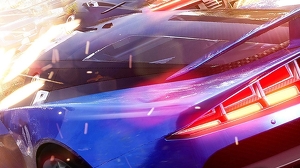
At what point do you release that Three Fields Entertainment really has delivered a worthy homage to the classic Burnout? For me, it’s really simple – it’s all about the boost drift. An arcade racing game is nothing without its drift mechanic, and in Dangerous Driving it’s the key to sustaining maximum velocity – essential not just for the racing and not just for the boost chains (or heat waves, as they’re now known) but also in maintaining ramming speed for those classic Takedowns. And yes, the good news is that Dangerous Driving doesn’t just nail sublime handling, the gladiatorial racing combat works beautifully too.
But the new Three Fields game isn’t really that most eagerly awaited of things – the so-called ‘spiritual successor to Burnout’ – because fundamentally, we’re looking at a small indie game here following in the footsteps of what eventually evolved into an EA triple-A juggernaut, before the firm bizarrely mothballed the franchise. Dangerous Driving was built by a team of seven using Unreal Engine 4 – a far cry from the fully staffed up Criterion, often rebuilding its technology from the ground up from one title to the next. With Dangerous Driving, the end result is something different then – the innovation is poured into game mechanics and race modes rather than into a vast array of complex maps and cars.
Playing Dangerous Driving, I think my colleague John Linneman hits the nail on the head: this is Burnout 3 viewed through the lens of Burnout 1, with the original game’s lower budget and stripped back presentation, merged with the raw essence of what made Burnout 3 so satisfying to play. Visually, the game may lack some of the variety of later Burnout games, but technically it’s on point: UE4 delivers a clean, post-process-heavy presentation and a wonderful motion blur implementation that accentuates the brutal speed this game delivers. However, the use of Unreal also underscores the wide divide in the Dangerous Driving experience depending on whether you’re playing on base or enhanced consoles.
Source: Eurogamer Dangerous Driving's sublime action and handling works best at 60fps

